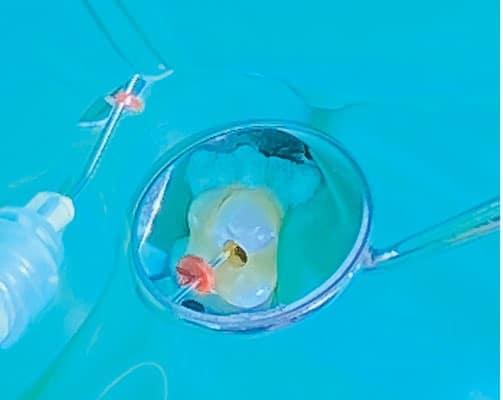Dr. Karl Woodmansey explains how NeoSEALER™ Flo can simplify the obturation process.
Dr. Karl Woodmansey discusses improved obturation with an emerging technique
Avalon Biomed’s™ new NeoSealer™ Flo is simplifying endodontic obturation. The goals of endodontic obturation have remained unchanged for decades; however, recent advances in bioceramic sealers now enable improved obturation with the simplicity and speed of inserting a single gutta-percha cone. This technique is generally termed, “the single-cone technique.” As specialists, endodontists are masters of all obturation techniques, including lateral compaction and warm vertical compaction, among others. These multistep procedures are proven to be successful, but the emergence of single-cone obturation using a bioceramic sealer is rapidly gaining acceptance. Simplicity, speed, and success are the reasons for this trend. Unlike the other techniques, single- cone obturation is sealer-centric — relying on the hydraulics imparted by the gutta-percha cone and the sealer’s flowability to three-dimensionally fill the canal space.

NeoSealer Flo is an affordable newly marketed sealer that has already proven itself. Based on the success of Avalon Biomed’s NeoMTA® Plus and NeoPUTTY™, this single-syringe bioceramic sealer is ideal for the single-cone technique. NeoSealer Flo is a non-staining, resin-free, dimensionally stable endodontic sealer with biocompatibility and bioactivity imparted by its bio-ceramic formulation.

Single-cone obturation requires only a few simple steps that can be accomplished in moments. My preferred technique follows.
After preparing with instruments and irri-gants, excess moisture is removed from the canal, and a gutta-percha cone is selected and fit to length. Most typically, the selected cone is one size smaller than the master apical file, but still binds at the determined working length. The slightly undersized cone permits adequate space for the NeoSealer Flo.
Next, the NeoSealer Flo is applied directly into the canal space using the Flex Flo Tip™, which is included in the kit. This unique application tip flexes and minimizes binding while the rubber stopper helps to gauge the appropriate canal depth. The barrel of the tip is designed with a small orifice that seats directly into the syringe tip, so waste is minimal. (The manufacturer claims an 81% reduction in waste compared to conventional tips based on its in-house testing.) The Flex Flo tip is inserted to one-half of the canal length, and then while slowly expressing sealer from the syringe, the tip is withdrawn from the canal. The goal is to fill the coronal one-half of the canal space. The pre-fitted gutta-percha cone is then slowly inserted through the NeoSealer Flo to the desired length. This insertion motion hydraulically distributes the NeoSealer Flo throughout the entire canal. After insertion of the gutta-percha cone, the canal’s obturation is complete. The top of the gutta-percha cone can be removed with a heated instrument, and any excess NeoSealer Flo can be cleaned up with a damp cotton pellet. A radiograph can then assess the adequacy of the obturation.
One common error is inadequate NeoSealer Flo application. An insufficient volume of NeoSealer Flo will not provide optimal hydraulics and will result in voids within the obturation. Some operators apply only a minimal amount of sealer, desiring to save a few pennies worth of material or fearing apical extrusion. With the minimum waste Flex Flo tip, this is not an issue with NeoSEALER Flo. When set, NeoSealer Flo is highly biocompatible such that apical extrusion is rarely consequential. Even so, caution should be exercised to prevent apical extrusion into the mandibular canal or maxillary sinuses.
Although there are multiple ways to modify or hybridize this technique, I have found this simple single-cone obturation protocol to work well in a wide variety of canal anatomies. Showcasing its versatility, some of my colleagues prefer to use NeoSealer Flo with modified techniques. For oval-shaped canals, some practitioners advocate adding gutta-percha points laterally (with or without a spreader) in a modified lateral compaction technique. Other endodontists feel more comfortable performing warm vertical compaction with this sealer. To date, no research has demonstrated any technique’s superiority. As long as basic endodontic principles are followed, all techniques with NeoSealer Flo should be highly successful. Even the fast and easy single-cone obturation technique with NeoSealer Flo should ensure a successful and enduring endodontic obturation.
This information was provided by Avalon Biomed™.
Read about Carolyn Primus, BS, MS, PhD, one of the innovators that collaborated to create NeoSEALER™ Flo here: https://endopracticeus.com/former-nuclear-weapons-engineers-gift-to-endodontics/
Stay Relevant With Endodontic Practice US
Join our email list for CE courses and webinars, articles and more..


